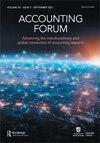Diffusion of the Balanced Scorecard: motives for adoption, design choices, organisational fit, and consequences
IF 3.4
4区 管理学
Q2 BUSINESS, FINANCE
引用次数: 2
Abstract
ABSTRACT The purpose of this exploratory study is to understand how the motives behind a Balanced Scorecard (BSC) adoption affect the BSC's design, organisational fit, and consequences from a diffusion theory perspective. Using semi-structured interviews, we follow up on three organisations that are long-term adopters of the BSC. We find that the motives for adopting the BSC do not follow the conventional model whereby early adopters have economic (rational) and late adopters non-economic (social) motives, but that these motives interact during the diffusion process. These organisations reframed the BSC and bundled it with other practices to achieve a better cultural, technical and political fit (i.e. top-management-related factors and IT systems). Cultural misfits are the most formative and can overpower technical and political aspects of fit. This has led to management practices that differ from the original design of the BSC. Also, we critically assess consequences of the BSC adoptions. Even adopters emphasising economic motives for adopting the BSC did not attempt to assess its ex-post financial impact. Thereby, our study contributes a critical view on fashionable management innovations.平衡计分卡的扩散:采用的动机、设计选择、组织契合度和结果
本探索性研究的目的是从扩散理论的角度了解采用平衡计分卡(BSC)背后的动机如何影响平衡计分卡的设计、组织契合度和后果。通过半结构化访谈,我们跟踪调查了三个长期采用平衡计分卡的组织。我们发现,采用平衡计分卡的动机并不遵循传统模型,即早期采用者具有经济(理性)动机,而后期采用者具有非经济(社会)动机,但这些动机在扩散过程中相互作用。这些组织重新定义了平衡计分卡,并将其与其他实践捆绑在一起,以实现更好的文化、技术和政治契合(即与高层管理相关的因素和it系统)。文化不适应是最具形成性的,可以压倒技术和政治方面的适应。这导致了不同于平衡计分卡最初设计的管理实践。此外,我们批判性地评估采用平衡计分卡的后果。即使是强调采用平衡记分卡的经济动机的采用者也没有试图评估其事后的财务影响。因此,我们的研究对流行的管理创新提供了批判性的观点。
本文章由计算机程序翻译,如有差异,请以英文原文为准。
求助全文
约1分钟内获得全文
求助全文
来源期刊

Accounting Forum
BUSINESS, FINANCE-
CiteScore
5.20
自引率
6.50%
发文量
0
期刊介绍:
Accounting Forum publishes authoritative yet accessible articles which advance our knowledge of theory and practice in all areas of accounting, business finance and related subjects. The journal both promotes greater understanding of the role of business in the global environment, and provides a forum for the intellectual exchange of academic research in business fields, particularly in the accounting profession. Covering a range of topical issues in accounting, business finance and related fields, Accounting Forum''s main areas of interest are: accounting theory; auditing; financial accounting; finance and accounting education; management accounting; small business; social and environmental accounting; and taxation. Of equal interest to practitioners, academics, and students, each issue of the journal includes peer-reviewed articles, notes and comments section.
 求助内容:
求助内容: 应助结果提醒方式:
应助结果提醒方式:


